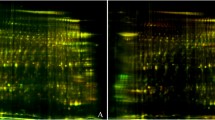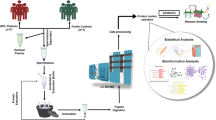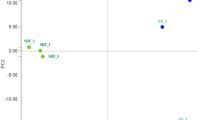Abstract
Purpose
To describe the proteomic profiles in semen samples and define the differences in sperm proteomic profiles among samples that ultimately achieved pregnancy (P) via intracytoplasmic sperm injection (ICSI) in an oocyte donation program and those that were unsuccessful (NP).
Methods
Prospective, analytical, observational nested case and control study evaluating the proteomic profile of spermatozoa from patients’ ejaculates where pregnancies were (group pregnant (P), n= 4) or were not (group non-pregnant (NP), n=4) achieved after ICSI in an oocyte donation program aiming to standardize female factor. Proteins were separated and analyzed by means of SWATH-MS) and compared between P/NP groups to identify sperm biomarkers of fertility/infertility. Proteins are available via ProteomeXchange.
Results
We identified and quantified 2228 proteins, with 37 significantly higher in the P group and 16 higher in NP. Enrichment analysis revealed that the increased proteins in P group sperm were related to motility, anaerobic metabolism, and protein biosynthesis functions, while the increased proteins in the NP group were involved in protein biosynthesis, protein folding, aerobic metabolism, and signal transduction, all of which are functions not previously described as influencing sperm success. Some proteins identified (e.g., SLC2A3, or CD81) are located in the cell membrane and thus may be employed to select spermatozoa by magnetic-activated cell sorting (MACS).
Conclusion(s)
This work revealed differences in the proteomic profiles of sperm samples successful in achieving pregnancy and those that were not, expanding our understanding of sperm function and infertility-related molecular markers, and enabling the future development of male fertility diagnostic tools and therapies.


Similar content being viewed by others
Data availability
N/A
Code availability
N/A
References
Reproductive Health Outlook. Infertility: overview and lessons learned, available:http://www.rho.org. 2002.
Benagiano G, Bastianelli C, Farris M. Infertility: a global perspective. Minerva Ginecol. Dipartimento di Scienze Ginecologiche Perinatologia e Puericultura, Universita degli Studi di Roma La Sapienza, Roma, Italy. Giuseppe.benagiano@uniroma1.it. 2006;58:445–57.
ESHRE. ART fact sheet 2020 data 2016. 2020. Available from: https://www.eshre.eu/ART-fact-sheet-2020-data-2016.
Sharlip ID, Jarow JP, Belker AM, Lipshultz LI, Sigman M, Thomas AJ, et al. Best practice policies for male infertility. Fertil Steril. Pan Pacific Urology, University of California, California, San Francisco, USA. 2002;77:873–82.
Thonneau P, Marchand S, Tallec A, Ferial ML, Ducot B, Lansac J, et al. Incidence and main causes of infertility in a resident population (1,850,000) of three French regions (1988-1989). Hum Reprod. INSERM (Institut National de la Sante et de la Recherche Medicale), Unite de Sante publique-Epidemiologie-Reproduction humaine, Centre Hospitalier Universitaire de Bicetre France. 1991;6:811–6.
Nallella KP, Sharma RK, Aziz N, Agarwal A. Significance of sperm characteristics in the evaluation of male infertility. Fertil Steril. Center for Advanced Research in Human Reproduction, Infertility and Sexual Function, Glickman Urological Institute, Department of Obstetrics-Gynecology, Cleveland Clinic Foundation, Cleveland, Ohio 44195, USA. 2006;85:629–34.
Altmae S, Salumets A. A novel genomic diagnostic tool for sperm quality? Reprod BioMed Online. Department of Clinical Science, Intervention and Technology, Division of Obstwetrics and Gynecology, Karolinska Institutet, Karolinska University Hospital Huddinge, Stockholm, Sweden; Competence Centre on Reproductive Medicine and Biology, Tartu,(TRUNCATED): Reproductive Healthcare Ltd. Published by Elsevier Ltd. All rights reserved. 2011;22:405–7.
Lewis SE. Is sperm evaluation useful in predicting human fertility? Reproduction. School of Medicine, Obstetrics and Gynaecology, Queen’s University Belfast, Institute of Clinical Science, Grosvenor Road, Belfast BT12 6BA, UK. s.e.lewis@qub.ac.uk. 2007;134:31–40.
Esteves SC. Clinical relevance of routine semen analysis and controversies surrounding the 2010 World Health Organization criteria for semen examination. Int Braz J Urol. ANDROFERT, Andrology and Human Reproduction Clinic, Campinas, SP, Brazil. 2014;40:443–53.
Esteves SC, Zini A, Aziz N, Alvarez JG, Sabanegh ES Jr, Agarwal A. Critical appraisal of World Health Organization’s new reference values for human semen characteristics and effect on diagnosis and treatment of subfertile men. Urology. Androfert, Andrology and Human Reproduction Clinic, Campinas, Brazil.: Elsevier Inc. 2012;79:16–22.
Sakkas D, Ramalingam M, Garrido N, Barratt CL. Sperm selection in natural conception: what can we learn from Mother Nature to improve assisted reproduction outcomes? Hum Reprod Update. Boston IVF, 130 Second Ave, Waltham, MA 02451, USA dsakkas@bostonivf.com.; Reproductive and Developmental Biology, Medical School, Ninewells Hospital, University of Dundee, Dundee DD19SY, UK.; IVI Valencia, Guadassuar 1 Bajo, 46015 Valencia, Spa(TRUNCATED): . Published by Oxford University Press on behalf of the European Society of Human Reproduction and Embryology. 2015;21:711–26.
Garrido N, Remohi J, Martinez-Conejero JA, Garcia-Herrero S, Pellicer A, Meseguer M. Contribution of sperm molecular features to embryo quality and assisted reproduction success. Reprod BioMed Online. Instituto Universitario IVI and FIVI, Andrology Laboratory and Semen Bank, Plaza de la Policia Local 3, Valencia 46015, Spain. nicolas.garrido@ivi.es. 2008;17:855–65.
World Health Organization. WHO laboratory manual for the examination and processing of human semen. 5th edn. In: Cooper DTG, editor. World Heal. Organ. Geneva: World Health Organization; 2010.
Rivera R, Garrido N. MM. Increasing the success of assisted reproduction by defining sperm fertility markers and selecting sperm with the best molecular profile. Expert Rev Obs Gynecol. 2012;7(4):346–62.
Sanchez V, Wistuba J, Mallidis C. Semen analysis: update on clinical value, current needs and future perspectives. Reproduction. Centre of Reproductive Medicine and Andrology, University Clinic Muenster, Domagkstrasse 11, D-48149 Muenster, Germany. 2013;146:R249–58.
Anton E, Krawetz SA. Spermatozoa as biomarkers for the assessment of human male infertility and genotoxicity. Syst Biol Reprod Med. Unitat de Biologia Cel.lular, Facultat de Biociencies, Universitat Autonoma de Barcelon , Bellaterra (Cerdanyola del Valles), Spain. 2012;58:41–50.
Said TM, Land JA. Effects of advanced selection methods on sperm quality and ART outcome: a systematic review. Hum Reprod Update. Andrology Laboratory and Reproductive Tissue Bank, The Toronto Institute for Reproductive Medicine (ReproMed), 56 Aberfoyle Crescent, Toronto, ON, Canada M8X 2W4. tsaid@repromed.ca. 2011;17:719–33.
Rivera-Egea R, Garrido N, Sota N, Meseguer M, Remohi J, Dominguez F. Sperm lipidic profiles differ significantly between ejaculates resulting in pregnancy or not following intracytoplasmic sperm injection. J Assist Reprod Genet. Andrology Laboratory and Sperm Bank, IVIRMA Valencia, Plaza de la Policia Local, n degrees 3, 46015, Valencia, Spain. rocio.rivera@ivirma.com.; Fundacion Instituto Valenciano de Infertilidad (FIVI), Instituto Universitario IVI (IUIVI), Avda/ Fer(TRUNCATED). 2018;35:1973–85.
Egea RR, Puchalt NG, Escriva MM, Varghese AC. OMICS: Current and future perspectives in reproductive medicine and technology. J Hum Reprod Sci. Andrology Laboratory and Semen Bank, Instituto Universitario, IVI Valencia, Spain.; Andrology Laboratory and Semen Bank, Instituto Universitario, IVI Valencia, Spain.; IVF Laboratory Instituto Universitario, IVI Valencia, Spain.; Dispur Polyclin(TRUNCATED). 2014;7:73–92.
Oliva R, de Mateo S, Estanyol JM. Sperm cell proteomics. Proteomics. Human Genetics Research Group, IDIBAPS, Faculty of Medicine, University of Barcelona, Barcelona, Spain. roliva@ub.edu. 2009;9:1004–17.
du Plessis SS, Kashou AH, Benjamin DJ, Yadav SP, Agarwal A. Proteomics: a subcellular look at spermatozoa. Reprod Biol Endocrinol. Center for Reproductive Medicine, Cleveland Clinic, Cleveland, Ohio, USA. 2011;9:36.
Li J, Zhang L, Li B. Correlative study on the JAK-STAT/PSMbeta3 signal transduction pathway in asthenozoospermia. Exp Ther Med. Reproductive Medicine Center, General Hospital of Beijing Military Region, Beijing 100700, P.R. China.; Department of Information, General Hospital of Beijing Military Region, Beijing 100700, P.R. China.; Department of Obstetrics and Gynecology,(TRUNCATED). 2017;13:127–30.
Martinez-Heredia J, de Mateo S, Vidal-Taboada JM, Ballesca JL, Oliva R. Identification of proteomic differences in asthenozoospermic sperm samples. Hum Reprod. Human Genetics Research Group, Genetics Unit, Faculty of Medicine, University of Barcelona, Casanova 143, 08036 Barcelona, Spain. 2008;23:783–91.
Saraswat M, Joenvaara S, Jain T, Tomar AK, Sinha A, Singh S, et al. Human Spermatozoa Quantitative Proteomic Signature Classifies Normo- and Asthenozoospermia. Mol Cell Proteomics. From the double daggerTransplantation laboratory, Haartmaninkatu 3, PO Box 21, FI-00014 University of Helsinki, Finland.; section signHUSLAB, Helsinki University Hospital, Helsinki, Finland.; section signHUSLAB, Helsinki University Hospital, Hel(TRUNCATED): by The American Society for Biochemistry and Molecular Biology, Inc. 2017;16:57–72.
Liao TT, Xiang Z, Zhu WB, Fan LQ. Proteome analysis of round-headed and normal spermatozoa by 2-D fluorescence difference gel electrophoresis and mass spectrometry. Asian J Androl. Institute of Human Reproduction and Stem Cell Engineering, Central South University, Changsha 410078, China. 2009;11:683–93.
Baker MA, Aitken RJ. Proteomic insights into spermatozoa: critiques, comments and concerns. Expert Rev Proteomics. ARC Centre of Excellence in Biotechnology and Development, Discipline of Biological Sciences, School of Environmental and Life Sciences, University of Newcastle, Callaghan, New South Wales 2308, Australia. mark.baker@newcastle.edu.au. 2009;6:691–705.
Amaral A, Castillo J, Ramalho-Santos J, Oliva R. The combined human sperm proteome: cellular pathways and implications for basic and clinical science. Hum Reprod Update. Human Genetics Research Group, IDIBAPS, Faculty of Medicine, University of Barcelona, Casanova 143, 08036 Barcelona, Spain. 2014;20:40–62.
Garin-Muga A, Odriozola L, Martinez-Val A, Del Toro N, Martinez R, Molina M, et al. Detection of Missing Proteins Using the PRIDE Database as a Source of Mass Spectrometry Evidence. J Proteome Res. Proteomics and Bioinformatics Unit, Center for Applied Medical Research, University of Navarra , 31008, Pamplona, Spain.; Proteomics and Bioinformatics Unit, Center for Applied Medical Research, University of Navarra , 31008, Pamplona, Spain.; I(TRUNCATED). 2016;15:4101–15.
Soda T, Miyagawa Y, Ueda N, Takezawa K, Okuda H, Fukuhara S, et al. Systematic characterization of human testis-specific actin capping protein β3 as a possible biomarker for male infertility. Hum Reprod. 2017;32:514–22. Available from: https://academic.oup.com/humrep/article-lookup/doi/10.1093/humrep/dew353.
Zylbersztejn DS, Andreoni C, Del Giudice PT, Spaine DM, Borsari L, Souza GHMF, et al. Proteomic analysis of seminal plasma in adolescents with and without varicocele. Fertil Steril. Elsevier Inc.; 2013;99:92–8. Available from: https://doi.org/10.1016/j.fertnstert.2012.08.048.
Azpiazu R, Amaral A, Castillo J, Estanyol JM, Guimera M, Ballesca JL, et al. High-throughput sperm differential proteomics suggests that epigenetic alterations contribute to failed assisted reproduction. Hum Reprod. Human Genetics Research Group, IDIBAPS, Faculty of Medicine, University of Barcelona, Casanova 143, Barcelona 08036, Spain. 2014;29:1225–37.
Gillet LC, Navarro P, Tate S, Rost H, Selevsek N, Reiter L, et al. Targeted data extraction of the MS/MS spectra generated by data-independent acquisition: a new concept for consistent and accurate proteome analysis. Mol Cell Proteomics. Department of Biology, Institute of Molecular Systems Biology, Eidgenossische Technische Hochschule Zurich, 8093 Zurich, Switzerland. 2012;11:O111.016717.
Hopfgartner G, Tonoli D, Varesio E. High-resolution mass spectrometry for integrated qualitative and quantitative analysis of pharmaceuticals in biological matrices. Anal Bioanal Chem. Life Sciences Mass Spectrometry, School of Pharmaceutical Sciences, University of Geneva, University of Lausanne, Quai Ernest-Ansermet, 30, 1211 Geneva 4, Switzerland. gerard.hopfgartner@unige.ch. 2012;402:2587–96.
Perez-Patino C, Barranco I, Parrilla I, Valero ML, Martinez EA, Rodriguez-Martinez H, et al. Characterization of the porcine seminal plasma proteome comparing ejaculate portions. J Proteome. Department of Medicine and Animal Surgery, Faculty of Veterinary Science, University of Murcia, Spain.; Department of Medicine and Animal Surgery, Faculty of Veterinary Science, University of Murcia, Spain.; Department of Medicine and Animal Sur(TRUNCATED): Elsevier B.V. 2016;142:15–23.
Garcia-Herrero S, Garrido N, Martinez-Conejero JA, Remohi J, Pellicer A, Meseguer M. Differential transcriptomic profile in spermatozoa achieving pregnancy or not via ICSI. Reprod BioMed Online. Instituto Universitario IVI Valencia, Universidad de Valencia, Valencia, Spain.: Reproductive Healthcare Ltd. Published by Elsevier Ltd. All rights reserved. 2011;22:25–36.
Garcia-Herrero S, Garrido N, Martinez-Conejero JA, Remohi J, Pellicer A, Meseguer M. Ontological evaluation of transcriptional differences between sperm of infertile males and fertile donors using microarray analysis. J Assist Reprod Genet. Instituto Universitario IVI Valencia, Universidad de Valencia, Valencia, Spain. sherrero@ivi.es. 2010;27:111–20.
Garcia-Herrero S, Meseguer M, Martinez-Conejero JA, Remohi J, Pellicer A, Garrido N. The transcriptome of spermatozoa used in homologous intrauterine insemination varies considerably between samples that achieve pregnancy and those that do not. Fertil Steril. Instituto Universitario IVI Valencia, Universidad de Valencia, Valencia, Spain.: American Society for Reproductive Medicine. Published by Elsevier Inc. 2010;94:1360–73.
Garrido N, Garcia-Herrero S, Meseguer M. Assessment of sperm using mRNA microarray technology. Fertil Steril. Andrology Laboratory and Sperm Bank, Instituto Universitario IVI Valencia, Valencia, Spain. nicolas.garrido@ivi.es: American Society for Reproductive Medicine. Published by Elsevier Inc. 2013;99:1008–22.
Shevchenko A, Jensen ON, Podtelejnikov AV, Sagliocco F, Wilm M, Vorm O, et al. Linking genome and proteome by mass spectrometry: large-scale identification of yeast proteins from two dimensional gels. Proc Natl Acad Sci U S A. Peptide and Protein Group, European Molecular Biology Laboratory, Heidelberg, Germany. 1996;93:14440–5.
Reimand J, Isserlin R, Voisin V, Kucera M, Tannus-Lopes C, Rostamianfar A, et al. Pathway enrichment analysis and visualization of omics data using g:Profiler, GSEA, Cytoscape and EnrichmentMap. Nat Protoc. Computational Biology Program, Ontario Institute for Cancer Research, Toronto, ON, Canada.; Department of Medical Biophysics, University of Toronto, Toronto, ON, Canada.; The Donnelly Centre, University of Toronto, Toronto, ON, Canada.; The Donn(TRUNCATED). 2019;14:482–517.
Vizcaino JA, Csordas A, Del-Toro N, Dianes JA, Griss J, Lavidas I, et al. 2016 update of the PRIDE database and its related tools. Nucleic Acids Res. European Molecular Biology Laboratory, European Bioinformatics Institute (EMBL-EBI), Wellcome Trust Genome Campus, Hinxton, Cambridge, CB10 1SD, UK juan@ebi.ac.uk.; European Molecular Biology Laboratory, European Bioinformatics Institute (EMBL-E(TRUNCATED). 2016;44:11033.
Pellicer A, Simon C, Remohi J. Effects of aging on the female reproductive system. Hum Reprod. Instituto Valenciano de Infertilidad, Valencia University School of Medicine, Spain. 1995;10(Suppl 2):77–83.
Soares SR, Velasco JA, Fernandez M, Bosch E, Remohi J, Pellicer A, et al. Clinical factors affecting endometrial receptiveness in oocyte donation cycles. Fertil Steril. IVI-Lisboa, Avenida Infante Dom Henrique, 333-H, 1800-282, Lisboa, Portugal. 2008;89:491–501.
Vernaeve V, Reis Soares S, Budak E, Bellver J, Remohi J, Pellicer A. Clinical factors associated with the outcome of oocyte donation. Gynecol Obstet Fertil. Instituto Valenciano de Infertilidad -Barcelona, 14, Ronda General-Mitre, 08017 Barcelone, Espagne. vernaeve@ivi.es. 2007;35:1015–23.
Uniprot Database: uniprot.org/.
Jin SK, Yang WX. Factors and pathways involved in capacitation: how are they regulated? Oncotarget. The Sperm Laboratory, College of Life Sciences, Zhejiang University, Hangzhou, China.; The Sperm Laboratory, College of Life Sciences, Zhejiang University, Hangzhou, China. 2017;8:3600–27.
Garrido N, Bellver J, Remohi J, Alama P, Pellicer A. Cumulative newborn rates increase with the total number of transferred embryos according to an analysis of 15,792 ovum donation cycles. Fertil Steril. Instituto Universitario IVI Valencia, University of Valencia, Valencia, Spain. nicolas.garrido@ivi.es: American Society for Reproductive Medicine. Published by Elsevier Inc. 2012;98:341–2.
Liu LM, Chen DY, Huang TH. Key sperm membrane proteins in sperm-egg fusion. Zhonghua Nan Ke Xue. Research Center for Reproductive Medicine, Department of Cell Biology and Genetics, Medical College of Shantou University, Shantou, Guangdong 515041, China. liulimin_123@yahoo.cn. 2009;15:261–4.
Carkci S, Etem EO, Ozaydin S, Karakeci A, Tektemur A, Ozan T, et al. Ion channel gene expressions in infertile men: A case-control study. Int J Reprod Biomed (Yazd, Iran). Department of Urology, Faculty of Medicine, Firat University, Elazig, Turkey.; Department of Medical Biology, Faculty of Medicine, Firat University, Elazig, Turkey.; Department of Medical Biology, Faculty of Medicine, Firat University, Elazig, T(TRUNCATED). 2017;15:749–56.
Sabetian S, Shamsir MS, Abu NM. Functional features and protein network of human sperm-egg interaction. Syst Biol Reprod Med. Department of Biological and Health Sciences, Faculty of Bioscience and Medical Engineering, Universiti Teknologi Malaysia , Johor , Malaysia. 2014;60:329–37.
Acknowledgements
We would like to thank the proteomics facility of SCSIE University of Valencia for the LC-MS/MS and SWATH-MS proteomic analysis. This proteomics laboratory is a member of Proteored, PRB3, and is supported by grant PT17/0019, of the PE I+D+i 2013–2016, funded by ISCIII and ERDF. We also would like to thank the statistics section of the SCSIE University of Valencia for the statistical analysis.
Funding
This study is supported by CDTI and Fondo Tecnológico. F.D participation was supported by the Spanish Ministry of Economy and Competitiveness through the Miguel Servet programme (CP013/0450) co-founded by FEDER.
Author information
Authors and Affiliations
Contributions
RR designed the study, selected the patients, performed the analysis, and wrote the paper; NS helped in the design of the study and performed the protein profile analysis; RG helped in the statistical approach; MM collaborated in the protein profile studies and in the writing of the paper; JR recruited many of the patients analyzed and helped in the design of the paper; FD helped in the statistical approach and monitored, coordinated the sperm analysis and helped in the writing of the paper; NG designed the study, performed the statistical analysis, and helped in the writing of the paper.
Corresponding author
Ethics declarations
Ethics approval and consent to participate
Written informed consent was obtained from all patients and the study was approved by the Ethics Committee of IVI Valencia (#1209-C-108-RR).
Consent for publication
N/A
Conflict of interest
The authors declare no competing interests.
Additional information
Publisher’s note
Springer Nature remains neutral with regard to jurisdictional claims in published maps and institutional affiliations.
Supplementary Information
ESM 1
(XLSX 1110 kb)
Rights and permissions
About this article
Cite this article
Rivera-Egea, R., Sota, N., González-Martín, R. et al. Differential sperm proteomic profiles according to pregnancy achievement in intracytoplasmic sperm injection cycles: a pilot study. J Assist Reprod Genet 38, 1507–1521 (2021). https://doi.org/10.1007/s10815-021-02098-0
Received:
Accepted:
Published:
Issue Date:
DOI: https://doi.org/10.1007/s10815-021-02098-0




